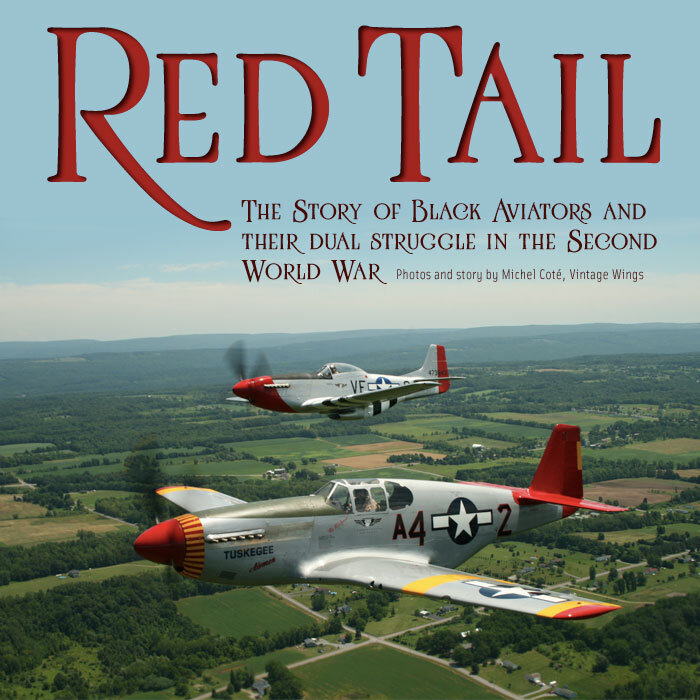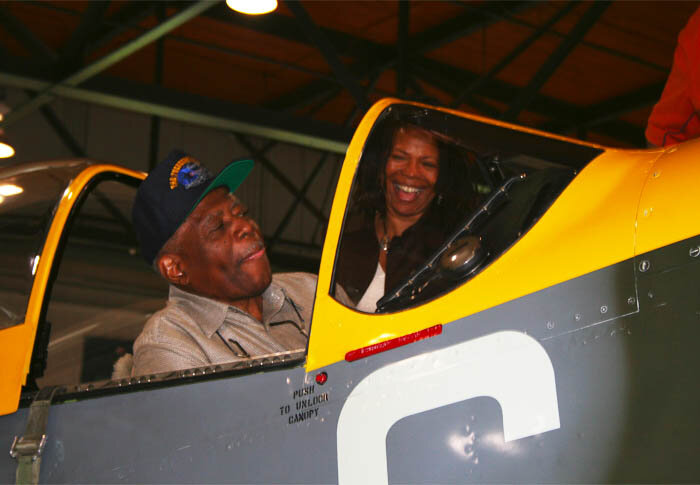REDTAIL - The Story of the Tuskeegee Airmen
At a very young age I was fascinated by aviation, especially the aircraft of the Second World War and the men who flew them into history. One group was the Tuskegee airmen known as the Red Tails when they were deployed to Europe. The story of their exploits was an inspiration for us all.
The Tuskegee Airmen were dedicated, determined young men who enlisted to become America's first black military aviators at a time when there were many people who thought that black men lacked intelligence, skill, courage and patriotism. They came from every corner of the country. Each of them had a strong personal desire to serve the United States of America to the best of his ability.
The black airmen who became single-engine or multi-engine pilots were trained at Tuskegee Army Air Field (TAAF) in Tuskegee Alabama. The first aviation cadet class began in July 1941 and completed training nine months later in March 1942. Thirteen started in the first class. Five successfully completed the training, one of them being Captain Benjamin O. Davis, Jr., a West Point Academy graduate. The other four were commissioned second lieutenants, and all five received Army Air Corps silver pilot wings.
Four hundred and fifty of the pilots who were trained at TAAF served overseas in either the 99th Pursuit Squadron (later the 99th Fighter Squadron) or the 332nd Fighter Group. The 99th Fighter Squadron trained on and flew P-40 Warhawk aircraft in combat in North Africa, Sicily and Italy from April 1943 until July 1944 when they were combined with three other all-black squadrons to form the 332nd Fighter Group in the 15th Air Force.
Their outstanding record during the Second World War was accomplished by men whose names will forever live in our memory. Each one accepted the challenge, proudly displayed his skill and determination while suppressing internal rage from humiliation and indignation caused by frequent experiences of racism and bigotry, at home and overseas. These airmen fought two wars - one against a military force overseas and the other against racism at home and abroad. Initially flying P-40 Warhawks and P-47 Thunderbolts. It is really when flying the P-51 Mustang Red Tails that they were recognized.
Beginning with the 99th in North Africa and Sicily, all four Tuskegee squadrons (including saw combat. Most joined the fight in the European Theatre of Operations and their combat record proved their worth. For many years the Tuskegee Airmen were said to have never lost a bomber they were tasked to escort. These valiant pilots were credited with shooting down no less than 109 German aircraft while flying over 15,000 sorties during 1,500 missions. They earned 150 Distinguished Flying Crosses and 744 Air Medals, which is truly remarkable when one notes that only 445 of the 992 Tuskegee-trained pilots were ever deployed overseas for combat. 150 black airmen were killed in training and combat - making the ultimate sacrifice for the country that resented them so much. [for more information, read our 2007 article Red Tail, -ed]
There is no doubt that the author has been intrigued by the Red Tail story for a long time, as witnessed by his collection of artifacts and books on the subject. Photo: Michel Coté
Taken at the 2010 Thunder Over Michigan Airshow, this Alabama National Air Guard F-16C Falcon has it’s tail painted to honor the Tuskegee Airmen. Photo: Michel Coté
This newspaper article of the day extols the skills and readiness of a new kind of warrior. (author's collection)
Related Stories
Click on image
Their combat record went a long way to changing the mindset of those they worked with; bomber crews often requested them for escorts, enemy pilots respected their courage and they earned themselves a nickname "Red Tails" for the distinctive all-red tail surfaces they sported.
Over the years I had the opportunity to meet several of these famous pilots such as Roscoe Brown , Lewis Brady, Nathaniel Black, Dennis Mills and Frank Gregory. In September 2007 as a volunteer with the Vintage Wings of Canada Foundation I had the opportunity to meet and photograph Dr. Eugene Richardson and his beautiful wife Helen. They were the guests of Vintage Wings of Canada for a personal tour of our collection and facility. A delightful man with a direct manner, an infectious sense of humour and warm handshake, Richardson was accompanied by United States embassy staff who were just as charmed with him as were Vintage Wings volunteers. Though he never flew the P-51 which was considered the quintessential "Red Tail" mount, Eugene was qualified to fly the massive Republic P-47 Thunderbolt and the Curtiss P-40 Warhawk.
The Richardsons were in Ottawa as guests of the Embassy of the United States of America to give a presentation about the Tuskegee Airmen at the Canada Aviation and Space Museum. From Vintage Wings, Eugene was to return to the Museum to give his presentation and there could be no better way to arrive there than by warbird!
Contact! Leaning from the cockpit of the Vintage Wings Mustang, Eugene Richardson warms up the crowd with a little pilot humour. Photo: Michel Coté
Ever the educator, Dr. Eugene Richardson explains the function of the rudimentary air speed indicator on the Vintage Wings Tiger Moth to United States Embassy staffers who escorted him to the hangar. After the war, Richardson went to college and earned a doctorate in education. He became a high school principal and now as a retired educator tours the U.S. (and Canada) speaking about and teaching the story of the Tuskegee Airmen. Photo: Michel Coté
The look on Dr. Richardson's face says it all. It was his first time in a Sabre and he was as excited about it as the 18-year old Richardson who joined other black aviators in Tuskegee must have been. Though already transitioned to the mighty P-47 "Jug" and the Warhawk, the war ended before Eugene was sent overseas. Happy not to have to kill and to be killed, Eugene was de-mobilized and sent home - he was still just 21 years old. Eugene's experiences inspired a generation of African Americans including his own son, Eugene Richardson III, who became a fighter pilot and an airline executive. Photo: Michel Coté
On July 2010, the last piece of the puzzle was the opportunity to have an air to air mission to photograph the Commemorative Air Force (CAF) P-51C Mustang painted in the Tuskegee colors. This was quite a thrill.
The 1941 Historical Aircraft Group Museum's “Greatest Show on Turf” in Geneseo, NY assembles every year a line-up of historic aircraft that would be the envy of any other airshow. This year was no exception with the presence of four P-51 Mustangs including a rare “C” model owned by the CAF.
The CAF Red Tail Project, part of the Commemorative Air Force, was founded to keep alive the story of the Tuskegee airmen. The aircraft has become a major attraction at air shows and other venues across North America.
The P-51C Mustang is painted in the colors that represent all the personnel that served in the Tuskegee Project including pilots, bombardiers, and all ground support personnel. After white pilots requested the Tuskegee Airmen to escort them, Col. B.O. Davis named his plane By Request in honor of the Tuskegee Airmen’s perfect record. The colors represent the four fighter squadrons in the 332nd Group; the red and yellow cowling represents the 302nd Fighter Squadron; the A on the side represents the 99th Fighter Squadron; the yellow banding on the wings represents the 301st Fighter Squadron and the red tips on the wings represent the 100th Fighter Squadron.
Flown by lead pilot Doug Rozendaal, the P-51C made its approach slowly towards our photo ship - the Historical Air Group Museum`s Beech C-45. It was like we had turned back the clock. it was a magnificent sight. I could imagine myself as a waist gunner in a B-17 bomber, seeing the Red Tail fighter escorting us to a successful mission and a safe return home. Soon after we were joined by the other CAF P-51D Mustang known as Red Nose piloted by John … “Skipper” Hyle. Both pilots did incredible flying by keeping a superb tight formation. Everyone on board will cherish this moment forever.
The CAF’s P-51C has been finished as a Red Tail Mustang to commemorate the Tuskegee Airmen. Photo: Michel Coté
Lead pilot Doug Rozendaal in the Red Tail P-51C makes his slow approach. Photo: Michel Coté
Photo: Pierre Lapprand
The CAF Mustangs show their attractive lines in the skies over Geneseo farmland. The P-51C is flown by Doug Rozendaal; The other CAF P-51D Mustang known as Red Nose is piloted by John “Skipper” Hyle.
Mustang Ballet! The two CAF Mustangs over Conesus Lake near Geneseo, NY. Photo: Michel Coté















